Balbharti Maharashtra State Board 12th Biology Textbook Solutions Chapter 1 Reproduction in Lower and Higher Plants Textbook Exercise Questions and Answers.
Maharashtra State Board 12th Biology Solutions Chapter 1 Reproduction in Lower and Higher Plants
1. Multiple Choice Questions
Question 1.
Insect pollinated flowers usually possess ………………
(a) sticky pollen with a rough surface
(b) large quantities of pollens
(c) dry pollen with a smooth surface
(d) light-colored pollens
Answer:
(a) sticky pollen with a rough surface
Question 2.
In ovule, meiosis occurs in ………………
(a) Integument
(b) Nucellus
(c) Megaspore
(d) Megaspore mother cell
Answer:
(d) Megaspore mother cell
![]()
Question 3.
The ploidy level is NOT the same in ………………
(a) Integuments and nucellus
(b) Root tip and shoot tip
(c) Secondary nucleus and endosperm
(d) Antipodals and synergids
Answer:
(c) Secondary nucleus and endosperm
Question 4.
Which of the following types require pollination but result is genetically similar to autogamy?
(a) Geitonogamy
(b) Xenogamy
(c) Apogamy
(d) Cleistogamy
Answer:
(a) Geitonogamy
Question 5.
If diploid chromosome number in a flowering plant is 12, then which one of the following will have 6 chromosomes?
(a) Endosperm
(b) Leaf cells
(c) Cotyledons
(d) Synergids
Answer:
(d) Synergids
Question 6.
In angiosperms, endosperm is formed by/ due to ………………
(a) free nuclear divisions of megaspore
(b) polar nuclei
(c) polar nuclei and male gamete
(d) synergids and male gametes
Answer:
(c) polar nuclei and male gamete
Question 7.
Point out the odd one.
(a) Nucellus
(b) Embryo sac
(c) Micropyle
(d) Pollen grain
Answer:
(d) Pollen grain
2. Very Short Answer Questions
Question 1.
The part of gynoecium that determines the compatible nature of pollen grain.
Answer:
Stigmatic surface.
Question 2.
How many haploid cells are present in a mature embryo sac?
Answer:
6 cells, 2 synergids, 1 egg cell, 3 antipodals.
Question 3.
Even though each pollen grain has 2 male gametes why at least 20 pollen grains are required to fertilize 20 ovules in a particular carpel?
Answer:
Angiosperms have phenomenon of double fertilization in which both the male gametes are utilized, one for fusion with egg cell to form zygote and other for fusion with secondary nucleus to form endosperm.
Question 4.
Megasporogenesis
Answer:
It is the process of formation of haploid megaspores from diploid megaspore mother cell.
Question 5.
What is hydrophily?
Answer:
Transfer of pollen grains in pollination process through agency of water is known as hydrophily.
Question 6.
The layer which supplies nourishment to the developing pollen grains.
Answer:
Tapetum
Question 7.
Parthenocarpy
Answer:
The condition in which fruit is developed without the process of fertilization is called parthenocarpy.
![]()
Question 8.
Are pollination and fertilization necessary in apomixis?
Answer:
Apomixis is formation of embryos without formation of gametes hence there is no need of pollination and fertilization.
Question 9.
The part of pistil which develops into fruit and seed.
Answer:
Ovary develops into fruit and ovules into seed.
Question 10.
What is the function of filiform apparatus ?
Answer:
Filiform apparatus guides the pollen tube towards egg cell.
3. Short Answer Questions
Question 1.
How polyembryony can be commercially exploited?
Answer:
- Polyembryony is the development of more than one embryo inside the seed.
- When such polyembryonic seed germinate we get multiple seedlings from it.
- This condition increases the chances of survival of new plants.
- Nucellar embryos are genetically identical to parent plants hence we get uniform plants.
- In horticulture we can utilize these as rootstock for grafting, hence they have significant role in fruit breeding programmes e.g. Citrus, Mango.
Question 2.
Pollination and seeds formation are very crucial for the fruit formation, Justify.
Answer:
- After fertilization, ovary is transformed into fruit, where ovary wall becomes fruit wall, i.e pericarp.
- Mature ovules are transformed into seeds after fertilization.
- Fertilization is a process where male gametes unites with female gamete to form zygote which develops into embryo.
- In pollination process pollen grains carrying non-motile male gamete are transferred on stigma.
- Seeds have embryo which germinate into new plant hence the goal of reproduction to create offspring for next generation is achieved. Hence these are the crucial events for fruit formation.
Question 3.
Incompatibility is a natural barrier in the fusion of gametes. How will you explain this statement?
Answer:
- Self incompatibility or self-sterility is a genetic mechanism that prevents germination of pollen on stigma of same flower. This favours cross pollination. E.g. Tobacco.
- In pollen-pistil interaction, when pollen grain is deposited on stigma, pistil has the ability to recognize and allow germination of right type of pollen.
- Special type of proteins on stigmatic surface determine compatibility or incompatibility.
- A physiological mechanism operates to ensure successful germination of compatible pollen.
- Compatible pollen absorbs water and nutrients from stigmatic surface that are absent in pollen and then pollen tube emerges which grow-s through style.
Question 4.
Describe three devices by which cross pollination is encouraged in Angiosperms by avoiding self-pollination?
Answer:
- Unisexuality, dichogamy, prepotency, heteromorphy and herkogamy are the outbreeding devices.
- Unisexuality : The plants bear either male or female flowers. Due to unisexual nature, self-pollination is avoided. Plants are either dioecious, e.g. Papaya or monoecious, e.g. maize.
- Heteromorphy : In same plants different types of flowers are produced. In these flowers, stigmas and anthers are situated at different levels. There is heterostyly and heteroanthy. This prevents self-pollination e.g. Primrose.
- Herkogamy : In bisexual flowers we may come across mechanical device to prevent self-pollination. Natural physical barrier avoids contact of pollens with stigma. E.g. Calotropis where pollinia are situated below the stigma.
4. Long Answer Questions
Question 1.
Describe the process of double fertilization.
Answer:
Double fertilization:
(1) Out of the two male gametes produced by the male gametophyte in angiosperms, one unites with the female gamete and the other with the secondary nucleus. Since both the male gametes take part in fertilization and fertilization occurs twice, it is called double fertilization.
(2) During double fertilization, the pollen tube on reaching the ovule enters the embryo sac through micropyle and bursts in one of the synergids. Owing to this, the two male gametes contained in the pollen tube, are set free.
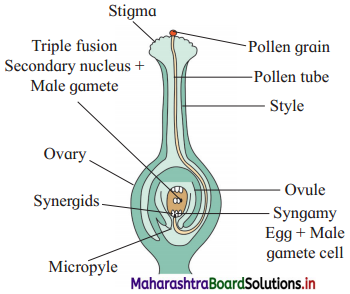
(3) Out of the two male gametes, one unites with the egg or female gamete and the other unites with the secondary nucleus of the embryo sac, forming a triploid or triple fusion nucleus, called the primary endosperm nucleus. The process involving the fusion of one of the male gametes with the egg nucleus, resulting in the formation of a diploid zygote is called syngamy.
(4) The reproductive process in which non-motile male nuclei are carried to the egg cell through a pollen tube is called siphonogamy.
(5) After fertilization, zygote develops into an embryo. Certain changes take place in the ovule leading to the development of a seed.
![]()
Question 2.
Explain the stages involved in the maturation of microspore into male gametophyte.
OR
Describe the development of male gametophyte before pollination in angiosperms.
OR
Sketch and label male gametophyte in angiosperm.
Answer:
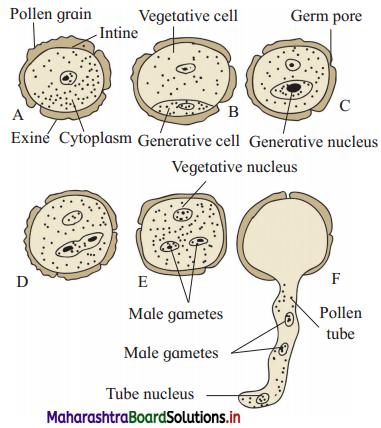
- Microspore or pollen grain is first cell of male gametophyte.
- The protoplast of pollen grain divides mitotically to form two unequal cells – a small thin walled generative cell and a large naked vegetative or tube cell.
- The generative cell possesses thin cytoplasm and a nucleus. It separates and floats in the cytoplasm of vegetative cell.
- The vegetative, possesses thick cytoplasm, irregular shaped nucleus and the reserved food.
- In majority of the angiosperms, the pollen grains are liberated at two-celled stage after the dehiscence of the anther.
- The generative cell of the pollen grain divides by mitosis to form two male non-motile gametes.
Question 3.
Explain the development of dicot embryo.
Answer:
Development of embryo (dicot) in angio- sperm:
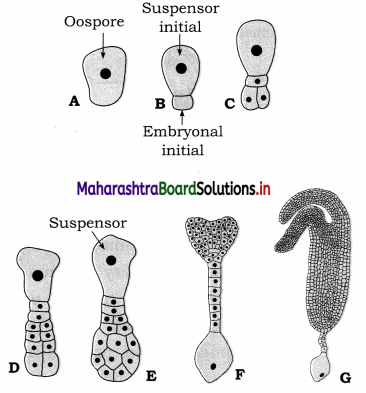
The oospore undergoes a transverse division to form a large basal cell towards the micropyle and a small apical or terminal cell towards the chalaza of the embryo sac. This two celled structure is called proembryo. The basal cell or suspensor initial undergoes repeated transverse divisions to form a multicellular structure called suspensor. The suspensor pushes the embryo towards the endosperm to draw its nutrition.
- The development of embryo from a zygote is called embryogenesis.
- The fusion of male gamete and an egg cell during fertilization results in the formation of a diploid zygote. The zygote develops a wall around it and is converted into oospore.
- The apical cell or embryonal initial of the proembryo undergoes a transverse division followed by two vertical divisions at right angles to form an octant stage.
- From octant, the lower four cells form hypocotyl and radicle while four cells of upper side form plumule with two cotyledons.
- The lowermost cell of suspensor is hypophysis and by its further division forms part of radicle and root cap.
- The cells from upper side of octant divide repeatedly to form heart shaped which elongated further to form two lateral cotyledons.
- Enlargement of hypocotyl and cotyledon results into curved embryo which appears horse shoe shaped.
Question 4.
Draw a diagram of the L.S of anatropous ovule and list the components of embryo sac and mention their fate after fertilization.
Answer:
Components of Embryo sac.
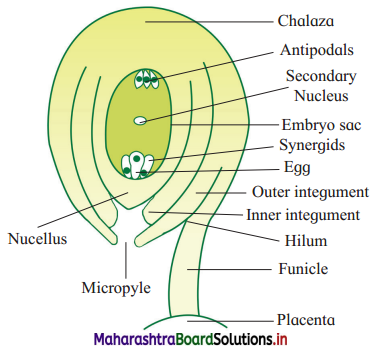
- Mature embryo sac is 7-celled and 8 nucleate.
- Egg apparatus at micropylar end – with 2 synergids and egg cell.
- Central cell with secondary nucleus formed by 2 polar nuclei
- Antipodal cells at chalazal end – 3 cells.
- Pollen tube enters the synergids, Synergids guide the growth of pollen tube towards egg.
- Male gamete fuses with female gamete, i.e. syngamy to form zygote which develops into embryo.
- One male gamete fuses with secondarynucleus to form primary endosperm nucleus (PEN) which forms endosperm, nutritive tissue for embryo.
5. Fill in the Blanks
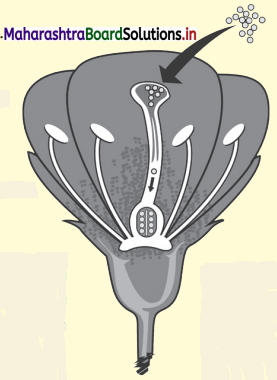
Question 1.
The ……………… collects the pollen grains.
Answer:
biotic agents
Question 2.
The male whorl, called the ……………… produces ………………
Answer:
androecium, pollen grains
Question 3.
The pollen grains represent the ………………
Answer:
male
Question 4.
The ……………… contains the egg or ovum.
Answer:
embryo sac
Question 5.
…………….. takes place when one male gamete and the egg fuse together. The fertilized egg grows vs into seed from which the new plants can grow.
Answer:
Fertilization
Question 6.
The ……………… is the base of the flower to which other floral parts are attached.
Answer:
thalamus
Question 7.
……………… is the transfer of pollen grains from anther of the flower to the stigma of the same or a different flower.
Answer:
Pollination
![]()
Question 8.
Once the pollen reaches the stigma, pollen tube traverses down the ……………… to the ovary where fertilization occurs.
Answer:
style
Question 9.
The ……………… are coloured to attract the insects that carry the pollen. Some flowers also produce ……………… or ……………… that attracts insects.
Answer:
petals, fragrance, nectar
Question 10.
The whorl ……………… is green that protects the flower until it opens.
Answer:
Calyx.
6. Label the Parts of seed.
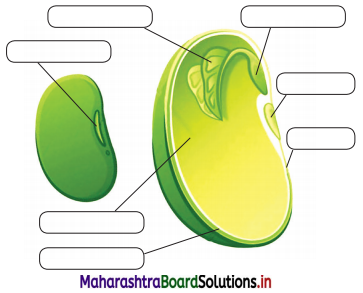
Answer:
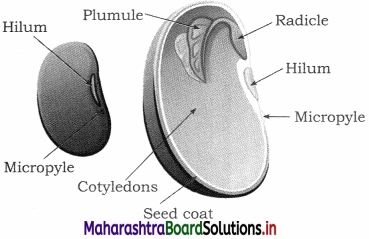
7. Match the following
| Column I (Structure Before seed formation) | Column II (Structure After seed formation) |
| A. Funiculus | i. Hilum |
| B. Scar of Ovule | ii. Tegmen |
| C. Zygote | iii. Testa |
| D. Inner Integument | iv. Stalk of Seed |
| v. Embryo |
![]()
(a) A-v, B-i, C-ii, D-iv
(b) A-iii, B-iv, C-i, D-v
(c) A-iv, B-i, C-v D-ii
(d) A-iv, B-v C-iii, D-ii
Answer:
(c) A-iv, B-i, C-v D-ii